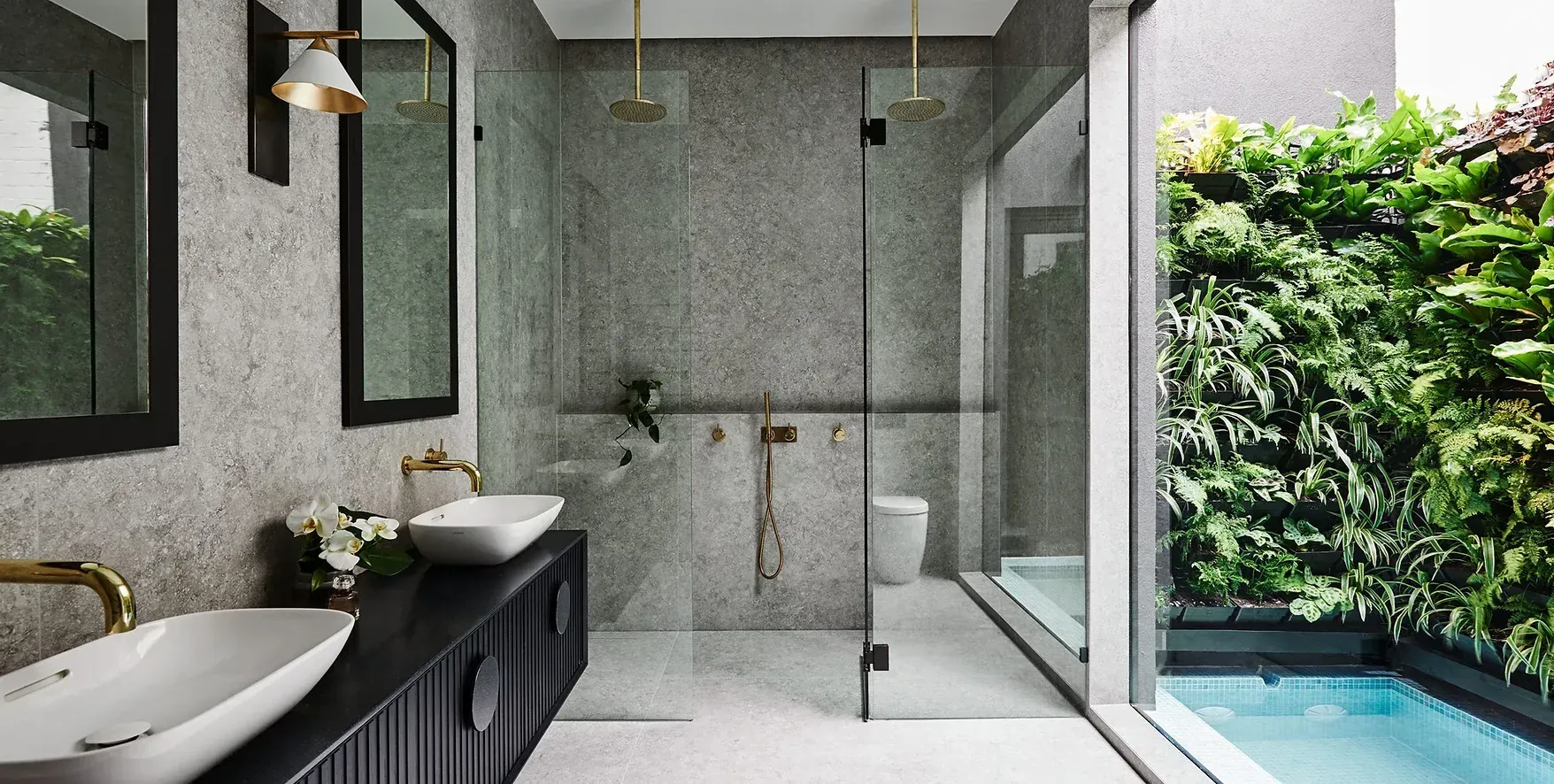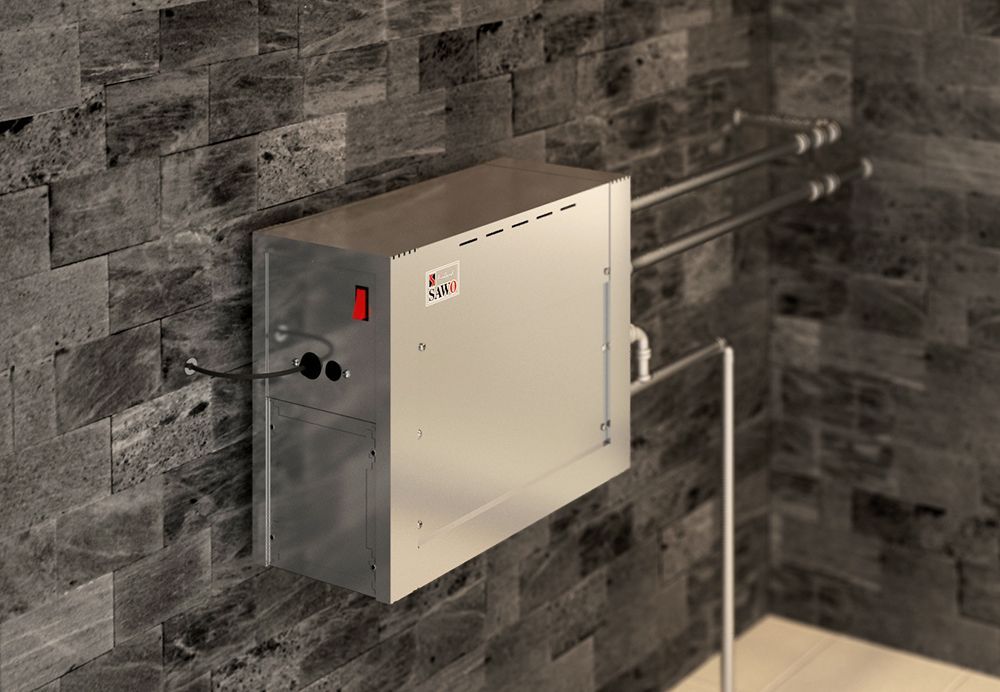Premium Steam Rooms
For all room sizes...
Steam Benefits
Medical research shows that steam bathing can provide the following health benefits:
Lowers Blood Pressure
Improves Skin Health
Eases Bronchitis Symptoms
Improves Blood Circulation
Steam Products
Please follow the links below to uncover information about SAWO steam equipment which we are sure you will find helpful and informative. As you will learn, SAWO Finland products are not only manufactured using the highest quality materials, they are innovative, practical and designed with you, our valued clients in mind.
Steam FAQ's
Have a steamroom related question? We’re here to help.
-
What is a steam room?
A steam room is an enclosed space designed to generate and maintain high humidity and temperature levels. In a steam room, a steam generator produces steam by boiling water, steam is released into the room to create a humid and warm environment. The temperature in a steam room typically ranges from 43°C to 49°C), with humidity levels close to 100%.
-
What is the difference between a sauna room and a steam room?
Sauna rooms and steam rooms are both popular types of heated spaces that offer relaxation and potential health benefits, but they differ in how heat and humidity are generated and the overall experience they provide.
Key differences between a sauna room and a steam room:
1. Heat Source:
Sauna Room: Saunas use dry heat generated by heating stones or electric heaters. The temperature in a sauna typically ranges from 70°C to 90°C+,, creating a hot and dry environment with low humidity levels (typically around 10-20%).
Steam Room: Steam rooms use moist heat generated by a steam generator that boils water to produce steam. The temperature in a steam room is lower than in a sauna, typically ranging from 43°C to 49°C, but the humidity levels are very high, close to 100%.
2. Humidity Levels:
Sauna Room: Saunas have low humidity levels (dry heat), which can range from 10% to 20%. This results in a more intense heat experience with less moisture in the air.
Steam Room: Steam rooms have high humidity levels (moist heat), close to 100%. The air in a steam room is saturated with steam, which feels moist and can be more soothing to the respiratory system.
3. Sensation and Experience:
Sauna Room: In a sauna, the intense dry heat promotes sweating and helps to relax muscles. The experience is characterized by a feeling of deep warmth and dryness, with the option to sprinkle water on heated stones to create bursts of steam.
Steam Room: In a steam room, the moist heat feels gentler on the skin and respiratory system. The high humidity can make it easier to breathe and promotes sweating, helping to cleanse pores and detoxify the body.
4. Material and Construction:
Sauna Room: Saunas are typically constructed using wood, such as cedar or pine, which can withstand high temperatures. The interior of a sauna often features wooden benches and walls.
Steam Room: Steam rooms are usually tiled or constructed using materials that can withstand high humidity levels. The surfaces are non-porous and easy to clean to prevent mold and mildew growth.
5. Health Benefits:
Both sauna rooms and steam rooms offer various health benefits, including relaxation, improved circulation, detoxification, muscle relaxation, and potential respiratory benefits.
Saunas are often preferred for their intense heat and potential cardiovascular benefits, while steam rooms are favored for their gentle, moisturizing heat and potential skin benefits.
In summary, the main differences between a sauna room and a steam room lie in the type of heat (dry vs. moist) and humidity levels they provide, as well as the overall sensation and experience they offer. Choosing between a sauna and a steam room often comes down to personal preference and your desired health journey. Send us an email if you would like more information on choosing the right one for you!
-
What are the benefits of using a steam room?
- Relaxation and stress reduction
- Improved circulation
- Detoxification through sweating
- Skin cleansing and hydration
- Respiratory relief for congestion
- Muscle relaxation and recovery after exercise
-
How is a steam room heated?
Steam rooms are typically heated by generating steam through the heating of water.
There are a few common methods for heating a steam room:
Steam Generator: A steam generator is a device specifically designed to produce steam. It consists of a tank or chamber where water is heated to produce steam, the steam is released into the steam room through vents or outlets. Steam generators may use electricity, gas, or other heating elements to heat the water.
The key is to heat water to the point where it evaporates into steam, creating the humid environment characteristic of a steam room. The steam is then circulated into the room to create the desired atmosphere for relaxation and wellness.
-
How hot does a steam room get?
Steam rooms typically range in temperature from 43°C to 49°C, with humidity levels close to 100%. There is no correct temperature it is a personal preference.
-
How long does it take for a steam room to reach operating temperature?
It usually takes around 20 to 30 minutes for a steam room to reach its desired operating temperature. However, this can vary depending on several factors, the size of the steam room, the type of heating system used, the starting temperature of the room, and the efficiency of the heating equipment. The door must also remain closed during the warm-up period.
-
What are the most important considerations when building a steam room?
Ensuring the room is waterproofed correctly and the steam does not escape the room. Standard waterproofing and grout products are not suitable for this purpose and qualified professionals should always be engaged to advise on and undertake these works. Other important considerations can be found here - along with a detailed pdf to download under the section entitled 'Steam Rooms' at the base of the page.
-
Does The Sauna Company build steam rooms?
No, we can assist with the necessary planning information when considering a steam room for your domestic or commercial project. Furthermore we can work alongside you with architects and builders.
The Sauna Company can assist with specifying which size of SAWO steam generator, steam equipment & accessories would be best for your project.
Email us for more information.
-
Can timber be used for steam room benching?
Timber is not a suitable material for the steam room & not recommended.
Moisture absorption can create a favourable environment for mould and mildew to develop on wooden surfaces. This can compromise hygiene and create maintenance challenges.
Instead of timber, consider using materials that are specifically designed for high-moisture and high-temperature environments, such as:
Ceramic or Porcelain Tile: These materials are non-porous, durable, and resistant to moisture and heat.
Concrete or Stone: These materials can be sealed and are highly resistant to moisture and heat. They also provide a solid and stable surface for seating.
When designing and constructing a steam room, prioritize materials that are resistant to moisture and heat to ensure safety, durability, and ease of maintenance. Consult with professionals experienced in steam room construction to select the most appropriate materials for your project.
-
What is the optimum height of a steam room?
For most residential and commercial steam rooms, a ceiling height of around 7 to 8 feet (approximately 2.1 to 2.4 meters) is often considered adequate.
Taller ceilings, up to 10 feet (approximately 3 meters) or more, can be suitable for larger steam rooms or to create a more open and spacious feel, this will require bigger steam generators to adequately heat the space.
Call to discuss with our professional staff to determine the most suitable ceiling height based on the specific dimensions and design of your steam room.
Follow manufacturer recommendations and industry guidelines for steam room construction, including ceiling height, insulation, and materials used.
Ultimately, the optimum ceiling height for a steam room is a balance between efficient steam distribution, user comfort, and overall design aesthetics. Tailor the ceiling height to suit the specific requirements and preferences of the steam room users while ensuring proper functionality and performance of the steam room system.
-
Is a single bench suitable in a steam room?
A single bench can be suitable and practical for certain steam room setups, particularly in smaller or personal steam rooms. However, for larger steam rooms or spaces intended for multiple users, consider incorporating additional seating options or multi-level benching to accommodate varying needs and preferences.
-
What kind of floor is appropriate for a steam room?
Consult with a professional contractor or one of our steam room consultants to determine the most suitable flooring option based on your specific steam room design, usage, and maintenance requirements. A waterproofed tiled, natural stone, or concrete floor are some of the most popular options. A compulsory floor drain within the steam room. is required. Ensure all installations comply with relevant building codes and regulations.
-
How long should I stay in the steam room?
Start with short sessions of 10-15 minutes and gradually increase the duration up to 20 minutes, based on your comfort level and tolerance to heat. If you have any health concerns about how long to stay in the steam room or how it may impact your health, consult with a qualified healthcare professional before use.
-
Who should not use a steam room?
Individuals with Cardiovascular Conditions:
- People with heart disease, high blood pressure (hypertension), or other cardiovascular conditions should avoid using a steam room without consulting their doctor first.
- Pregnant Women:
- Individuals with Respiratory Conditions: Such as asthma, or other respiratory conditions should use caution when using a steam room.
- Children under the age of 12 should always be accompained by an adult.
- Individuals with Skin Conditions:
- Individuals under the Influence of Alcohol or Drugs
- Dehydrated Individuals:
Before using a steam room, it's essential to assess your health status and consult with a healthcare provider if you have any concerns or underlying health conditions. They can provide personalized guidance on whether steam room use is safe for you and recommend appropriate precautions based on your individual health needs.
-
Is it safe for small children to be in the steam room?
It is generally not recommended for children, especially those under the age of 12, to use a steam room. Steam rooms can pose certain risks to young children due to their developing physiology and sensitivity to heat and humidity.
-
Are there any health risks associated with using a steam room?
Risks may include dehydration, overheating, and exacerbation of certain health conditions. Drink plenty of water before and after using a steam room and monitor your body's respons
-
Can I use electronic devices in a steam room?
It's not recommended to bring electronic devices into a steam room due to the high humidity, which can damage electronics
-
How do I know what steam generator to get for my project/home?
Email us!
When considering a Sawo steam generator for your steam room project, it's important to assess your specific needs in terms of steam output, space requirements, and desired features. Send us an email, with your room measurements/specifciatons and we can access the most suitable Sawo steam generator model for your application.
Sawo steam generators are recognized for their quality craftsmanship, performance, and reliability, making them a popular choice among individuals and businesses seeking efficient steam room solutions
.
-
Can I have the controls inside the Steam room?
No, Outside the Steam Room is highly recommended. Protection from steam and moisture: Controls placed outside the steam room are shielded from direct exposure to steam and moisture, potentially extending their lifespan & avoiding damages.
-
What's the purpose of a steam controller?
Steam controls are used to manage the operation of a steam generator and regulate the steam production within the steam room. They provide users with the ability to adjust the temperature and humidity levels to achieve their desired comfort and therapeutic experience.
-
Can a steam generator be placed outside?
Yes, Deciding where to place a steam generator for a steam room installation involves careful consideration of several factors related to accessibility, ventilation, plumbing, and safety. Here are some guidelines for choosing the location to install a steam generator, whether inside or outside the house:
General Considerations for Both Indoor and Outdoor Installation:
- Compliance with Local Codes: Check local building codes and regulations for steam room installations, including requirements for electrical wiring, plumbing, and ventilation.
- Proximity to Steam Room: Install the steam generator as close as possible to the steam room to minimize plumbing runs and heat loss in steam delivery. SAWO recommends a maximum of 7.5m from the steam room outlet in the room. Common locations are nearby utility room, laundry, basement or outside wall (if installed outside a waterproof cover with adequate ventilation will be required to ensure the unit does not get wet).
- Steam Generator must be accessible and minimum clearance guidelines must be followed to allow for servicing when required.
- Professional Installation: Steam generator installation should be done by a qualified technician or contractor experienced in steam room installations to ensure safety and compliance with manufacturer specifications.
-
Does my steam generator require regular maintenance or servicing?
Sawo steam generators are available in various KW, ranging from lower capacities (e.g., 3 kW) suitable for smaller steam rooms to higher capacities (e.g., 9 kW, 12 kW, 18 kW, etc.) for larger steam rooms.
- The power rating of the steam generator will determine the electrical load it draws and the corresponding circuit breaker and wiring requirements.
1. Circuit Breaker and Wiring:
- Ensure that the electrical circuit supplying power to the steam generator is equipped with a suitable circuit breaker and wiring capable of handling the rated electrical load (amperage) of the steam generator.
- Consult with a qualified electrician to determine the correct circuit breaker size and wiring specifications based on the specific power rating of the steam generator.
2.Installation Requirements:
- Follow all manufacturer's guidelines and local electrical codes/regulations for the installation of the steam generator. Installation should be performed by a licensed electric
-
How much does servicing cost?
We have a service call out fee which is determined by your location & then the technician is charged out as an our hourly rate on top of that call out fee. We offer discounts to clients that purchase our products aswell as clients that lock in servicing contract of 12 months or more.
We service across Melbourne and Victoria. Email us for more information
-
What does a steam service call out cover?
Upon inspection perform visual inspections of the steam generator components, including the heating elements, water reservoir, controls, and fittings.
Look for signs of wear, corrosion, leaks, or damage & perform the following:
- Cleaning of the steam generator(s)
- Descaling
- Water Quality Testing
- Safety Valve Testing
- Electrical Inspection & technician work(s)
- Seal Maintenance
- Steam Outlet Maintenance
- Control Panel Calibration
- Consider scheduling professional maintenance and inspection of your steam generator annually or as recommended by our qualified technician
- Photo documentation
By performing regular maintenance on your steam generator, you can prolong its lifespan, maintain optimal performance, can also identify problems before they occur and ensure a safe and enjoyable steam bathing experience. Following the manufacturer's guidelines and The Sauna Company recommendations for maintenance intervals and procedures specific to your steam generator model for either Domestic or Commercial use can reduce the possibility of damage & inconvenience of downtime as well as extend it’s lifetime of the equipment.
Contact Us
Ready to Unwind?
Fill out the form below to get the exact cost + timeline for your sauna oasis.
Contact Us
We will get back to you as soon as possible
Please try again later






